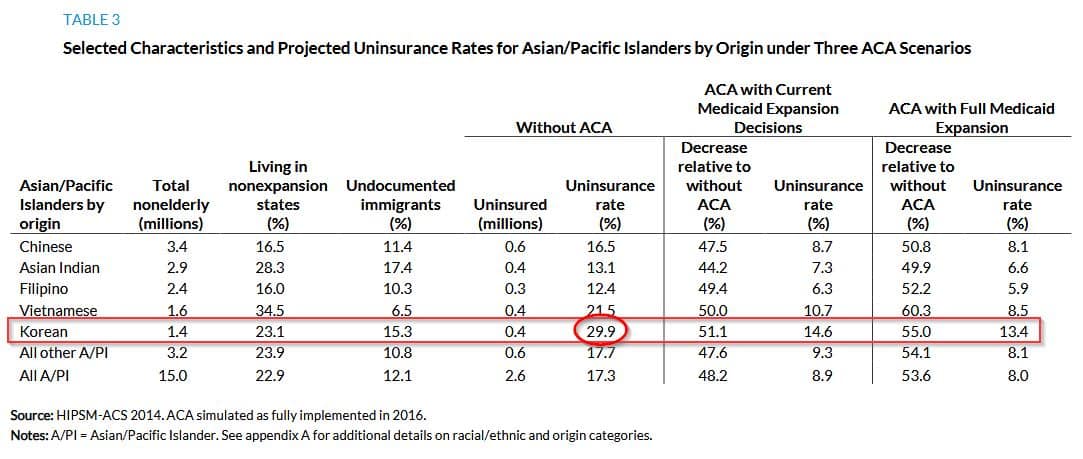In 2018, for the first time since data tracking began, the Korean American uninsured rate matched the national average at 8.7%, lower than the national average of 8.9%. However, before the Affordable Care Act, a significantly higher percentage of Korean Americans lived, attended school, or worked without health insurance. In 2010, 26.8% of Korean Americans were uninsured, compared to the national average of 15.5%. In Los Angeles County, which has the largest number of Koreans outside of Korea, more than 40% of Korean Americans were uninsured in 2001. An Urban Institute simulation of 2014 federal data concluded that, without the Affordable Care Act, 29.9% of Korean Americans would be uninsured, a higher rate than for all other Asian Americans.
Several factors contribute to the difficulties Korean Americans face in accessing adequate healthcare. First, the American healthcare system is complex and bureaucratic, making it challenging for anyone to navigate, especially immigrants who do not speak or understand English well. According to the 2022 Census, 29.7% of Korean Americans speak English less than “very well.” As a result, Korean Americans use the healthcare system the least among Asian Americans due to cultural and language barriers.
Second, the high uninsured rate may be explained by the type of work many Korean Americans are forced to choose. Immigration patterns and lack of English proficiency led a significant portion of new arrivals to find unskilled work and eventually own small businesses. In 2010, over 10% of Korean Americans were self-employed in unincorporated owned businesses, compared to the national rate of 6%. To save costs, many entrepreneurs were either unable to or chose not to obtain healthcare coverage for themselves, their families, or their employees. Additionally, as small business owners or workers in mom-and-pop operations, many Korean Americans work long hours, limiting their ability to seek regular medical checkups even if they had insurance.
Furthermore, older Korean American immigrants who moved to the U.S. to join their adult children do not qualify for Medicare, posing financial barriers to accessing healthcare. A 2018 multi-state study by the University of Hawaii at Manoa found that almost 30% of older Korean American immigrants experienced mental distress, but only 5.7% had used professional mental health services. The prevalence of mental distress among elderly Korean Americans was significantly higher than the average national rate, with 22% claiming their mental health status to be either fair or poor, compared to the 9-10.3% range reported by older non-Hispanic Whites.
Unfortunately, data that could help ascertain the physical and mental health status of Korean Americans is limited or unavailable, as most datasets combine all Asian participants into one category instead of disaggregating the statistics to each granular sub-group level.
Reports from the 2019-2021 National Health Interview Survey (NHIS) show that 10.4% of Korean Americans report their health “in general” as only “fair” or “poor,” similar to the national average but worse than other Asian Americans except for Filipino Americans at 11.9%.
Reports from the 2004-2008 National Survey on Drug Use and Health (NSDUH) indicate high rates of substance use and abuse among Korean Americans. Slightly more than half reported alcohol use in the past month, close to the national average of 55% but significantly higher than the 40% reported by other Asian Americans. The Korean American rate of binge drinking (25.9%) exceeds both the national rate (24.5%) and other Asian Americans (13%). While 5.3% of Korean Americans reported illicit drug use, lower than the national rate of 8%, it is higher than the 3.4% reported by other Asian Americans.
A Johns Hopkins University study found that, among Asian Americans during 2003-2013, Korean Americans had the highest prevalence of past-year substance use at 22.7% and the highest prevalence of binge drinking at 5.4%.
